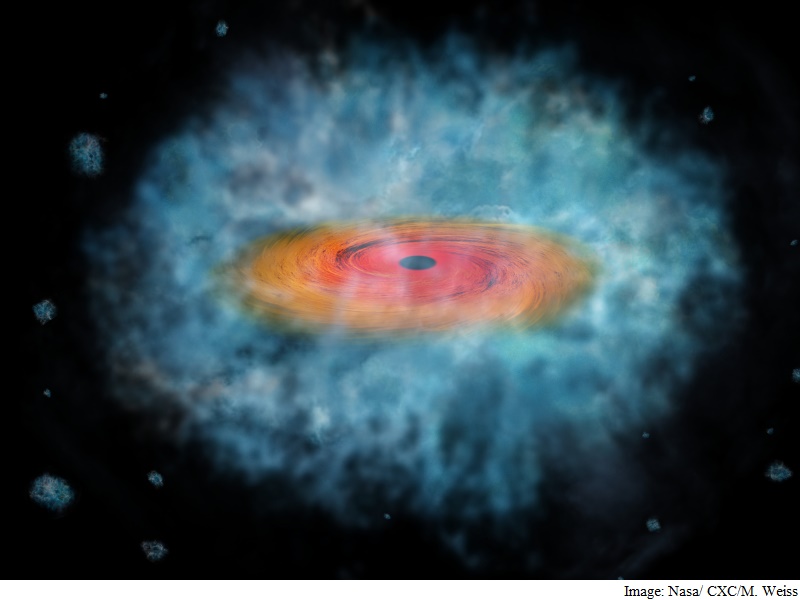- Home
- Science
- Science News
- Desert Scope Stakes Out Supermassive Black Hole
Desert Scope Stakes Out Supermassive Black Hole

This means they will be able to observe the star's movements in more detail than ever before, in an important test for Albert Einstein's theory of general relativity.
Dubbed S2, the star lies about 25,000 light years from our Solar System.
It is the celestial body known to make the closest approach to our galaxy's central black hole, named Sagittarius A, on a 16-year elliptical orbit.
S2 is a relative youngster in astronomical terms no more than 100 million years old.
It has been studied before, but in much less detail than can now be observed by the European Southern Observatory's Gravity instrument in Chile's Atacama desert.
"The Gravity observations will be about 15 times more accurate," said project leader Frank Eisenhauer of the Max Planck Institute for Extraterrestrial Physics in Germany, and recalled "a lot of high fives" when S2 came into focus.
Gravity combines the light from Europe's four largest telescopes to create a combined 130-metre (427-foot) diameter lense with "much sharper" imaging.
It will seek out miniscule but telltale deviations in the movement of gas and stars swirling around Sagittarius A ultimately proving its existence.
Sagittarius A is thought to be four million times more massive than our Sun.
Black holes are regions in space-time where mass is collapsed into such a small area that gravity takes over completely, and nothing, not even light, can escape making them invisible.
Was Einstein right?
Their existence is inferred from the behaviour of objects nearby, including stars swirling around them as planets orbit our Sun.
Black holes were theorised in Einstein's gravity theory, which was published in 1915 and still forms a bedrock of modern physics.
It has withstood every single experimental test to date, but the theory fails to explain some of the forces in the Universe particularly those at the subatomic, quantum level.
If Einstein was right, the Gravity team would expect to see minute changes in S2's orbit in the extreme gravity environment nearest Sagittarius A.
And they managed to set up their instrument just in time.
In 2018, S2 will make its closest approach to the black hole on its egg-shaped orbit "just" 17 light hours or 18 billion kilometres (11 billion miles) away.
It will travel at nearly 30 million kilometres per hour or 2.5 percent of the speed of light, just out of reach of the black hole's all-devouring reach.
"The trick is to measure its (S2's) orbit in the year before and the year after its closest approach, because the effects of general relativity strongly increase when you approach the black hole," Eisenhauer told AFP.
It would resemble an "extra kick" as the star shaves past, "and it's this 'kick to the orbit' we want to see," he said.
The next time S2 will be this near will be in 16 years.
Catch the latest from the Consumer Electronics Show on Gadgets 360, at our CES 2026 hub.
Related Stories
- Samsung Galaxy Unpacked 2025
- ChatGPT
- Redmi Note 14 Pro+
- iPhone 16
- Apple Vision Pro
- Oneplus 12
- OnePlus Nord CE 3 Lite 5G
- iPhone 13
- Xiaomi 14 Pro
- Oppo Find N3
- Tecno Spark Go (2023)
- Realme V30
- Best Phones Under 25000
- Samsung Galaxy S24 Series
- Cryptocurrency
- iQoo 12
- Samsung Galaxy S24 Ultra
- Giottus
- Samsung Galaxy Z Flip 5
- Apple 'Scary Fast'
- Housefull 5
- GoPro Hero 12 Black Review
- Invincible Season 2
- JioGlass
- HD Ready TV
- Laptop Under 50000
- Smartwatch Under 10000
- Latest Mobile Phones
- Compare Phones
- Honor Win RT
- Honor Win
- Xiaomi 17 Ultra Leica Edition
- Xiaomi 17 Ultra
- Huawei Nova 15
- Huawei Nova 15 Pro
- Huawei Nova 15 Ultra
- OnePlus 15R
- Asus ProArt P16
- MacBook Pro 14-inch (M5, 2025)
- OPPO Pad Air 5
- Huawei MatePad 11.5 (2026)
- Xiaomi Watch 5
- Huawei Watch 10th Anniversary Edition
- Acerpure Nitro Z Series 100-inch QLED TV
- Samsung 43 Inch LED Ultra HD (4K) Smart TV (UA43UE81AFULXL)
- Asus ROG Ally
- Nintendo Switch Lite
- Haier 1.6 Ton 5 Star Inverter Split AC (HSU19G-MZAID5BN-INV)
- Haier 1.6 Ton 5 Star Inverter Split AC (HSU19G-MZAIM5BN-INV)

















